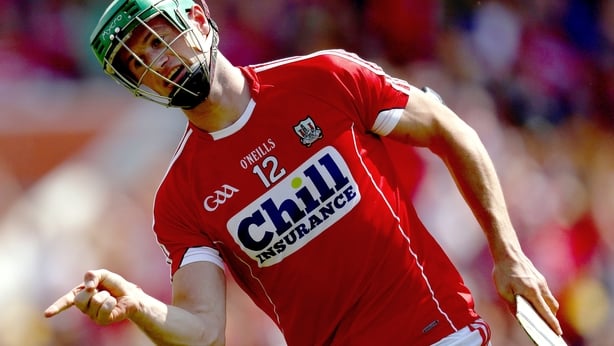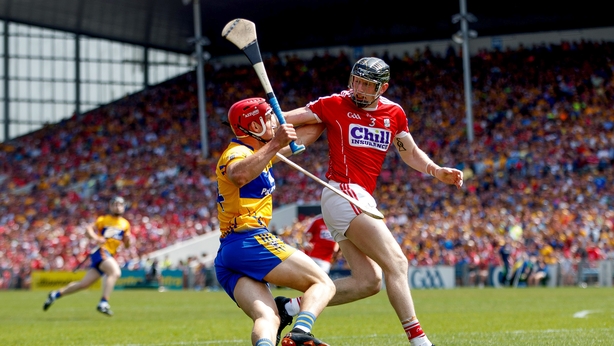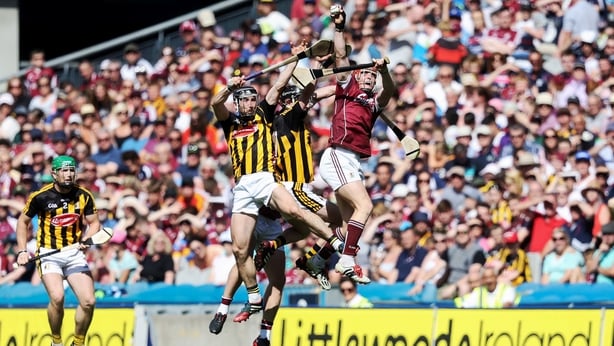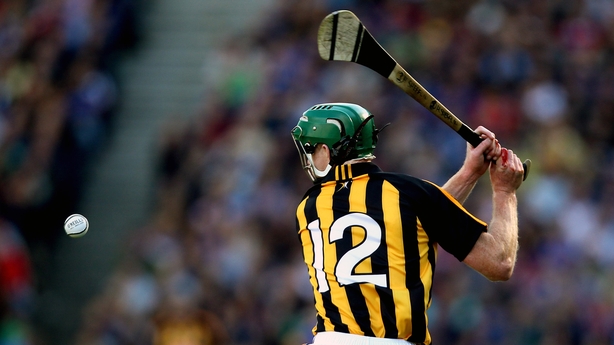When Padraig Walsh made his third outstanding catch during the first half of Sunday’s Leinster final, Garry Mac Donncha neatly captured the impact of Walsh’s fielding in his RTE TV commentary.
"We’re seeing a display of catching from Padraig Walsh," said Mac Donncha, "that will go down in the annals of time."
It was high-fielding for the ages but Walsh’s authority under the high ball was an apt metaphor for a game defined by brilliant high catching.
Over the 70 minutes, there was 31 high catches made in 50-50 aerial duels, which was possibly the most made in a big game in Croke Park this decade.
One of the best scores of the game was John Donnelly’s point late on, which was absolute Route 1.
That statistic highlighted the sheer physicality, and savage intensity of the match. It also underlined the comparative difference between that game and the Munster final played earlier in the day.
In Thurles, there were just 12 high-catches in 50-50 aerial duels. It was a far more open and expansive game. There were 12 more scores. There were five goals in Thurles and none in Croke Park.
Aesthetically, the general consensus was that Cork-Clare was a free-scoring classic and that Galway-Kilkenny was an arm-wrestle. Yet there was great beauty in the ferocity of the tackling and the unrelenting intensity of the hurling in Croke Park.
It was the beautiful game, just in a different form.
And nothing underlined that more than the quality and volume of high-fielding. Clare and Cork are different teams to Galway and Kilkenny, especially stylistically, but they aren’t physically equipped to play the same kind of power game. They don’t have anything like the same number of aerial ball-winners but Cork and Clare's best high fielders – Seamus Harnedy and John Conlon – were two of the best players on the field in Thurles.
Harnedy was deservedly man-of-the-match. From 12 plays, he scored 1-4 from play, set up Luke Meade’s goal, and was fouled for two converted frees.

Of the six high 50-50 balls that Cork won, Harnedy secured half of that total. And he turned that possession into a huge bounty. When Clare were ahead by eight points just before half-time, Harnedy signalled to Anthony Nash that he wanted the puckout. Nash drove it straight down the middle, Harnedy caught it ahead of Patrick O’Connor before releasing to Meade who drove the sliotar past Donal Tuohy.
From his other two high catches, Harnedy scored one point and was fouled for a converted free.
Conlon’s move to full-forward has given Clare a massive focal point and scoring threat in that area. His physical presence and power has also given Clare a huge long-ball option to the full-forward line. Conlon makes the ball stick but even if he doesn’t win clean possession, he makes sure it doesn’t come out easily.
The supply in the first half on Sunday was more measured than bombed long and Conlon caused massive damage. Of the nine direct balls Clare played into Conlon in that half, he won seven. From that possession, Conlon scored five points and was fouled for a converted free. He also had a goal chance saved by Nash.
Damien Cahalane couldn’t handle Conlon. Cork shifted Colm Spillane on to Conlon but his first act was to foul the Clare-man for a converted free.
It looked at that stage that Cork couldn’t get any grip on Conlon but Spillane gradually did. He physically matched up well but Cork’s defensive set-up was far better after the break.
Cork shifted Mark Coleman to wing-back and pushed Christopher Joyce back into the number six position. Joyce played more of a holding role, which gave Cork a better defensive shape.

Cork’s workrate in the middle third was far superior than the first half which further contaminated the supply into Conlon. Of the eight balls Clare directly played into him in the second half, Conlon only won three, two of which he was fouled for.
The supply was nothing like the same measured quality from the opening half and Clare eventually brought Conlon out to the half-forward line in the 63rd minute to try and get him on the ball again.
Clare’s primary ball-winner in the half-forward line is Peter Duggan but Cork switched Eoin Cadogan onto Duggan from the outset to negate that aerial threat.
Duggan made two excellent high catches in the second half but Cadogan spent most of the game trying to spoil Duggan in the air. That has become a key tactic in hurling now; stopping that aerial threat by getting the ball quickly to the ground and then hoovering it up to begin the counter-attack.
Most teams don’t have that overall capacity to win enough clean possession in the air, but Galway and Kilkenny certainly do. That aerial ability was a huge part of Kilkenny’s dominance under Brian Cody.
Being able to win your own ball was always a pre-requisite under Cody. They have had some of the best forwards to ever play the game but their self-sufficiency up front was a massive part of Kilkenny’s armoury.

"We didn’t have to overthink our game and style of play," wrote Jackie Tyrrell in his autobiography ‘The Warrior’s Code’. "Defenders had the luxury of thinking: ‘Just get the ball down there, as long and as high as possible. It doesn’t matter because those boys will win it.’"
Kilkenny had to change that way of thinking this year after Waterford and Wexford disarmed that long-ball tactic last summer.
Kilkenny are playing a more measured game now but, when the game becomes a war – as it did on Sunday – their natural instincts kick in. One of the best scores of the game was John Donnelly’s point late on, which was absolute Route 1.
Donnelly fetched a long puckout from Eoin Murphy before striking it straight over the bar. From the resultant Galway puckout, Cillian Buckley made a miraculous catch on the edge of the Kilkenny D.
Despite the way hurling is gone, where the game is largely defined by pace and space and passing precision, the importance of being able to win clean possession, especially in the air, will always be paramount. And that should always frame a key part of underage coaching practise and player development.
In his autobiography, Henry Shefflin told a story about how his father built a squash court behind the family pub in Ballyhale in 1976. He was hoping to turn it into a steady stream of income but maintenance costs were high and Shefflin wrote how his father eventually came to regret the move.

Yet for Shefflin’s own hurling development, that squash court was one of the greatest investments the family ever made. Shefflin and his brother Paul spent countless hours, especially over the winter, honing their skills on that court.
They beat a pattern into the back wall.
The brothers would take shots at each other into a makeshift goal but one of the most important skills they were subconsciously developing was high catching, through tussling for possession under a dropping ball.
"Thirty years on," Shefflin wrote, "that drill was still the one I hated most in Kilkenny training: Brian Cody positioning two players in the middle of the field and landing high balls in on top of them. It calls for real physical contact that you just can’t simulate."
Two players tussling for possession is the best method for developing the tools required to execute the skill of high catching; co-ordination; timing; increasing vertical jumping power; how to use your body properly during the engagement; learning the tricks often necessary to disengage an opponent in that situation.
And for the all the fancy and intricate hurling drills now out there, one of the most basic drills should always be a key one in every coaches portfolio.


